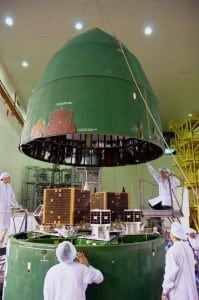Latest News
[Via Satellite 09-12-2014] Small satellite manufacturer SpaceQuest is looking to accelerate the pace of launches for its satellites. In December 2013 the company launched AprizeSat 7 and AprizeSat 8, and in June 2014 it launched two more satellites. But the limited availability of cost-effective launch options for small satellites, or SmallSats, has become a hindrance.
“What we really need is dedicated launches for four to six of our satellites into orbits of our choosing, and we would like to do that within the next three years,” Dino Lorenzini, president and CEO of SpaceQuest told Via Satellite.
The past eight launches for SpaceQuest have been with Kosmotras, whose Dnepr rockets — made from converted Intercontinental Ballistic Missiles (ICBMs) — have regularly carried several dozen small payloads into orbit at once. But the company is looking at other possibilities.
“We don’t have a launch manifested yet. There are several launch opportunities, [including] another with a Dnepr in 2016, where we can put up a couple of small satellites,” he said. “There are also opportunities on U.S. launchers, like SpaceX and others, but most of the ones we’ve looked at are too expensive for us. We are looking to get a much better deal on the launch costs, something similar to what we can get with the Dnepr.”
Lorenzini said SpaceQuest is closely watching upcoming dedicated SmallSat launchers such as Firefly Space Systems and Rocket Labs. These new entrants have the potential to breathe life into an already accelerating industry sector. But Lorenzini remains cautious.
“Many of them are quoting some pretty attractive prices, but historically those costs usually double or triple by the time they get into an operational system,” he explained. “On the other hand, anyone who can come up with a small satellite launcher at an affordable price is going to clean up because there is a huge demand building. We’ve got a lot of people sitting on satellites that don’t have launches.”
“It’s not just cost,” added Patrick Shannon, VP of SpaceQuest, “it’s also being able to dictate the orbit you go into. With the small satellite constellations that are all going up on rideshares, their orbital planes and their distribution is going to be rough. If they get dedicated launches, you get a much better plane, your constellation is worth more to you, and your service is better.”
Lorenzini said SmallSats that piggyback launches end up flying near wherever the primary payload is going. If this is an imaging satellite as primary, then the secondary will likely end up in a 10:30 sun-synchronous orbit. SpaceQuest wants to enter different orbits to diversify its constellation.
SmallSats present a challenge to launch providers, however, as they are more difficult to monetize than larger spacecraft. Despite ever-growing popularity, their low cost appeal has some drawbacks in the market.
“[SmallSats] do not currently comprise a significant market force, however this could change if the use of SmallSats as replacement for large satellites gains traction,” Avascent analysts said in an email. “Commercial growth may be most likely to come from communications companies exploring ways to exploit [Low Earth Orbit] LEO and [Medium Earth Orbit] MEO to serve niche markets that have been traditionally unserved or underserved, and from Earth Observation applications that require continuous global monitoring (e.g., remote sensing, weather).”
Despite this, Avascent analysts did say SmallSat launchers are “an idea whose time has come,” though primarily for LEO. The analysts do not expect SmallSats to gain a sense of priority in the launch market until the number of dedicated SmallSat launchers grows.
“One other factor that may affect market development is the emergence of business models that could serve as anchor clients for these services, e.g., NASA, DoD, or commercial ventures such as Google’s Project Loon,” said Avascent analysts.
There are several factors actively shaping the dedicated SmallSat launchers market.
These providers must determine launch rate, launch sites, and prove they are reliable. Avascent analysts said insurers might prefer fewer satellites per launch, potentially driving demand for the vehicles. Dedicated launchers would also provide greater stability, as customers would not have to play second fiddle to larger players. For SpaceQuest, Lorenzini remains hopeful that this market will strengthen with time.
“Some of these companies are getting close,” he said. “I think if they had a little outside funding they might be able to move their schedule up quite a bit, but with the launch business there is always a lot of risk and fault … Sooner or later one or two are going to penetrate. It might take five to eight years, but I hope not.”
Get the latest Via Satellite news!
Subscribe Now